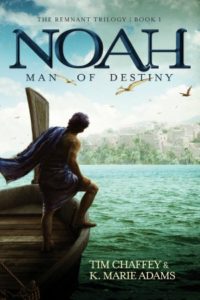Whether escaping legendary beasts, tracking kidnappers, or pursuing his future wife, Noah acquires the skills he will need when God calls him to his greatest adventure: surviving the global Flood. Noah: Man of Destiny (Master Books) is the first book in the Remnant Trilogy. In this interview, co-authors Tim Chaffey and K. Marie Adams explain why Noah’s story is still so important, how their roles at Answers in Genesis impacted the novel, and how their version of Noah is different from portrayals we’ve seen before…
 Q: Why is Noah’s story still so important?
Q: Why is Noah’s story still so important?
Tim—There are so many reasons why Noah’s story means a lot for us today. The Bible makes no secret about the wickedness in Noah’s day and there are a lot of ways our world is growing increasingly wicked. However, I think we’re nowhere near to what God says about the evil in Noah’s day, not when He declares that every thought of every person was continuously evil. As bad as our news gets, we still hear of how ungodly people behave decently towards humankind. So Noah serves as an example to me of following God in the midst of a culture that is even worse than the one I live in.
Through reading about his choice to stand for the Creator, I’m emboldened to take a similar stance. Taking a closer look at this man has also made me realize that his walk with God would have been limited in that he didn’t know of Jesus’ finished work on the cross, he didn’t have the completed canon of scripture, and there’s no mention of his knowing the influence of the Spirit. As we were writing the book, we stuck with only three names for God to help show this limited understanding. Writing this book made me not take for granted the blessings I have in this age where I can read my Bible, I can rely on the Spirit for guidance, and I can be restored and redeemed because of Jesus’ death, burial, and resurrection.
Q: How did your role at Answers in Genesis impact the writing or direction of the novel?
Tim – As the content manager for the Attractions Division, I was responsible to develop the content for the exhibits at the Ark Encounter. One of the exhibits is called Who Was Noah? I was tasked with coming up with a short backstory, based on the scant details in Scripture, to explain how Noah could have acquired the skills necessary to build the Ark. So I thought about having Noah work as a shipbuilder for much of his life. I like to say that God often equips those He calls and He calls those He equips. With that concept in place, I was able to develop a coming-of-age story that would take Noah from his childhood home through captivating adventures and grave dangers to the point that he becomes the Bible’s Ark builder.
My role at Answers in Genesis impacted the story greatly in other ways. Working behind the scenes on the Ark Encounter, I was able to see many of the props and images and work some of them into the story. I did the same thing with some of the Ark’s audio scripts, so that our story matched the Ark Encounter’s backstory.
My position also kept the story from becoming too fanciful. The pre-Flood world offers so many opportunities to create something like a fantasy world. While we took advantage of that to some degree, we knew it was important to stay rooted in Scripture and to keep the story aligned to ministry positions.
Kendyl – I was a part of the design team, working on visually communicating the message through signs for the various exhibits. I got to help influence the names of the wives and worked with some of the other designers on which props should be included. Several of the elements in the first book were fabricated and included on the Ark as we were in the middle of the writing process. One of my favorite exhibits to work on was The Door. We’re not there yet in Noah’s timeline for the book, but I wanted to use that space as an opportunity to deal with the reality of a worldwide judgment. I wanted to show one of our characters wrestling with what it would be like to deal with the loss of all of
One of my favorite exhibits to work on was The Door. We’re not there yet in Noah’s timeline for the book, but I wanted to use that space as an opportunity to deal with the reality of a worldwide judgment. I wanted to show one of our characters wrestling with what it would be like to deal with the loss of all of mankind, but to still trust in the goodness and mercy of God. I wanted it to be a place of personal reflection because everyone’s asked themselves at some point in their lives about death and suffering, and if God can be both fully just and fully loving.
Q: How does this version of Noah differ from portrayals we may have seen before?
Tim—Our Noah is quite different than those seen in movies and read about in books. Obviously, we did not turn Noah into a brutal madman like the recent blasphemous Hollywood film. I’ve read over a half-dozen novels about Noah in the pre-Flood world, and their depiction of Noah is rather stereotypical—he owns a vineyard, likes his wine a little too much, and he’s the only righteous person in the whole world.
Our story starts with Noah as a young man on the cusp of adulthood. And although he is surrounded by God-fearing people in his younger years, he is not aware of all the details in the early chapters of Genesis. He knows some of the truths, but some of the ideas have become mere legends by Noah’s day. We get to watch him face trials, stumble and fall, learn to depend on his Creator, and overcome temptations.
We also incorporate many of the biblical figures from Genesis 4–6 in unique ways. In fact, we intentionally avoided many of the stereotypes about Noah and his world that are not clearly spelled out in Scripture. In doing this, we want to challenge readers to consider whether their ideas are found in Scripture or are merely part of traditions that have filled in the areas where Scripture is silent.
Q: How much of this book is speculation and/or artistic license vs. what we actually know about the real events?
 Kendyl—The Bible has some information, but there is a lot of room for wonderment between the few details it gives us about Noah. Tim and I were careful to stay true to the parts that are in Scripture, but then everywhere else we used artistic license. However, just because there is freedom, doesn’t mean that you have to stretch things beyond probability. We gave ourselves some boundaries for our creativity. First off, no pizza or aliens. 🙂
Kendyl—The Bible has some information, but there is a lot of room for wonderment between the few details it gives us about Noah. Tim and I were careful to stay true to the parts that are in Scripture, but then everywhere else we used artistic license. However, just because there is freedom, doesn’t mean that you have to stretch things beyond probability. We gave ourselves some boundaries for our creativity. First off, no pizza or aliens. 🙂
Second, we remained mindful of the fact that we’re writing about real people, some of whom we’re going to meet someday. I don’t want to have to be completely embarrassed when I meet Noah and his family. Third, Tim’s done a ton of research on the pre-Flood world and other works of fiction dealing with this time period. We both agreed that there are some things Christians often assume about Noah and they think it’s in the Bible, but it’s not. We wanted to take those elements and run the other direction. Our goal with that is to get our readers to think and to challenge them to reread what the Bible actually says about this well-known story. We want to encourage people to go back to God’s word.
Q: Although this is a novel, there are special notes at the end to help readers contextualize what they’ve read. How important is it that readers understand the real-life applications of the story?
Tim—We have three unique sections at the end of the book. The “Borrowed from the Bible” section tells readers where we’ve borrowed ideas found elsewhere in Scripture in an attempt to rein in the amount of artistic license. The “Encounter This” section tells readers where they can find at the Ark Encounter the various items and animals used in the novel.
The extended Q&A at the end of the story helps readers understand the biblical basis for the decisions we made, and it answers many of the skeptical questions of our day. This section is where readers get to see our primary goal in writing the series. As strange as it sounds, our goal was to use fiction to help readers learn to discern between their own ideas and biblical truth.
Q: What is it about telling a story that makes something so much more real than a series of facts?
 Tim – Stories often engage people in ways that nonfiction rarely does. If the stories are written well and have interesting characters, readers often become emotionally invested in the story. Key events and situations come alive in the readers mind, and they might picture themselves in the various settings facing similar challenges. When it comes to historical fiction, particularly about such an important biblical character, readers might gain fresh insights about people they’ve known about all along, but they may have never considered certain details.
Tim – Stories often engage people in ways that nonfiction rarely does. If the stories are written well and have interesting characters, readers often become emotionally invested in the story. Key events and situations come alive in the readers mind, and they might picture themselves in the various settings facing similar challenges. When it comes to historical fiction, particularly about such an important biblical character, readers might gain fresh insights about people they’ve known about all along, but they may have never considered certain details.
For the record, authors can also become emotionally invested in the story, and this lends authenticity to the characters. For my own part, a couple of the chapters in the second novel were quite difficult to write, but I won’t give any spoilers to explain why.
Kendyl—Jesus often used stories to engage his audience in a spiritual truth, so I think the use of fiction can be a very effective way to teach biblical principles in a way that is memorable and enjoyable. The unique thing about this series, is that people have a chance to not only immerse themselves in Noah’s life through the fictional account we created, but they can then feel like they’re actually a part of his world when they go visit the Ark. They’ll be able to hear the sounds of a myriad of animals as they walk throughout the decks of the ship. They can start to take the same road we did when we began asking ourselves, “What would it be like for Noah….” and hopefully through that, the righteous choices that Noah made and God that he stood for will become of even greater importance in their lives.
Q: This is the first book in a series. What comes next and what’s the timeline for when readers can expect it?
Tim—The second book is called Noah: Man of Resolve, and we hope to see it released this spring. We’re currently editing the final chapters, so we’re getting close. We plan to release the third book, Noah: Man of God, about a year later. Each of these novels will also include the three sections in the back of the book.


